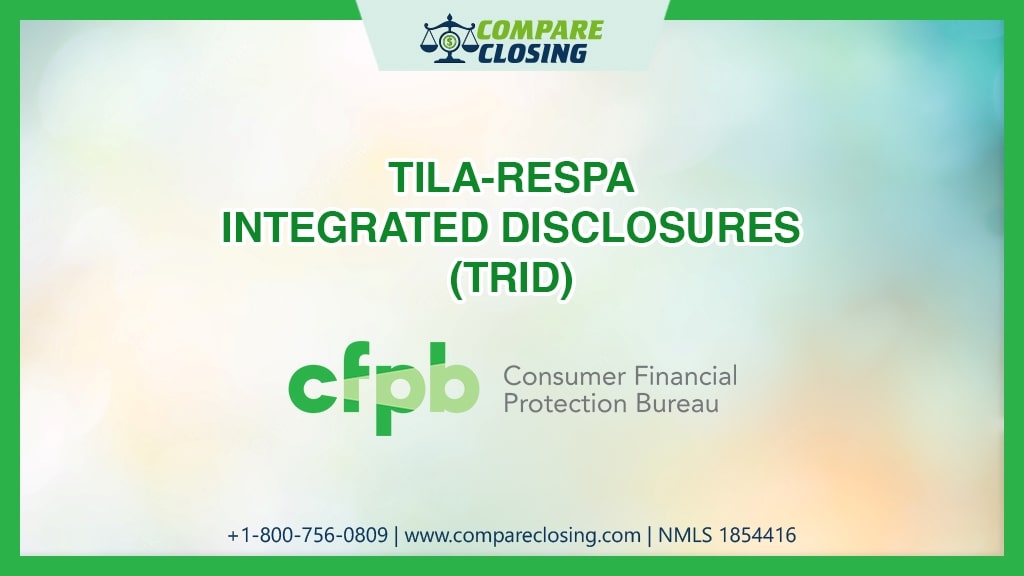Table of Contents
- What Are Netting Escrows & How Does It Work?: The Best Guide - January 2, 2024
- The Secret About Prescriptive Easement: Top Guide 1 Must Know - December 4, 2023
- About Home Equity Loans In Texas And How Can One Obtain It - November 27, 2023
About TRID
When you are looking to get a mortgage or refinance your existing one, as per the guidelines your lender needs to provide you with disclosures that help you as a borrower to understand the terms and cost of financing your home.
In this post, we will understand what is TILA-RESPA Integrated Disclosure (TRID) in detail.
What Is TRID?
TRID, also known as “Know before you owe”, is an acronym for the TILA-RESPA Integrated Disclosure rule. It became law as part of the Consumer Protection Act and Dodd-Frank Wall Street Reform.
Dodd-Frank Sections 1098 and 1100A require the appropriate regulator to issue forms and rules that require mortgage companies to combine disclosure information that consumers receive when they apply for a home mortgage loans under Truth in Lending (TILA) and settlement disclosure under the Real Estate Settlement Procedures Act (RESPA).
TILA-RESPA Integrated Disclosure is a set of guidelines imposed by the Consumer Financial Protection Bureau (CFPB) to close some of the gaps used by exploitative lenders to mislead borrowers.
The TRID rule determines what mortgage information a lender must provide to the consumer. This rule also defines the way banks and lenders can charge their fees and how they can be modified as the mortgage matures.
The rule helps the consumer to better understand the best mortgage loan options and to select the right lender.
As of 2015, all mortgage lenders must comply with the TIRD rule when offering a mortgage or providing a loan estimate to the borrower.
The reason why this rule is also called “Know Before You Owe” is because it contains information about fees, loans, and payments that consumers should read and understand before putting an offer to the seller or committing to refinancing the existing mortgage.
What Type Of Disclosures Are Included In TRID?
Under the mortgage TRID rule, the lenders are required to provide two types of disclosures as mentioned below.
Loan Estimate: A loan estimate is provided by the lender within three days from the date the borrower’s loan application is received. It includes the interest rates, payments, principal loan amount, and fees for the mortgage that the consumer qualifies for.
Loan estimates can change from the beginning of the mortgage process to the end of the mortgage process, but lenders cannot make significant changes to the terms of the mortgage and must provide these estimates in good faith during the pre-approval process.
You can use loan estimates from several competing mortgage companies to see how much home you can afford and who can offer the best mortgage terms.
If a lender provides you with a loan estimate does not mean that you cannot shop around and work with some other lender if the mortgage terms are competitive.
Closing Disclosure: Once all the loan requirements are fulfilled and you are ready to close on the loan, the lender is required to provide you with a closing disclosure three days prior to the closing date of your loan.
The closing disclosure will include the same information that was provided to you in the loan estimate. However, the numbers on the CD will be final and would not change unless there is a major change in circumstances.
The best practice is to compare your closing disclosure with the loan estimate that you received earlier.
If you see a change in the interest rate, principal loan amount, loan term, or additional fees, you should confront your loan officer and ask for an explanation for these changes.
How Does The Lender Comply With TRID Guidelines?
As a lender, you have to adhere to these guidelines when you receive an application from a potential borrower. Below mentioned are some important rules that the lender must follow.
Application Fee Waiver: Under these guidelines, mortgage lenders cannot charge you a fee before providing a loan estimate except a credit report fee that is used for checking your credit and obtaining a credit report.
Prompt Delivery of Loan Estimate: The lenders are required to provide the loan estimate to the loan applicant within three days from the date of application.
Contact Information: Lenders are required to provide contact information and a way to contact the lender when evaluating your credit.
Estimates and Disclosure Archives: Lenders must keep copies of their loan estimate for at least three years and closing disclosure for at least five years from the closing date.
Three-Day Waiting For Closing Disclosure: The closing disclosure would be provided by the lender three days prior to the closing date of your mortgage.
If there are any changes in the final CD, the lender should provide an updated one and wait for three more days before you can close on the loan.
Conclusion
As a borrower TRID guidelines can help you to protect yourself from unethical lending practices by the lenders and ensure that you receive the disclosures and estimates on time.
It will also provide you an opportunity to compare multiple estimates from competing lenders and help you choose the mortgage that is cost-effective and matches your need.
As a seller, you can anticipate the closing time so that you can plan your move accordingly.
Amanda Byford
Amanda Byford has bought and sold many houses in the past fifteen years and is actively managing an income property portfolio consisting of multi-family properties. During the buying and selling of these properties, she has gone through several different mortgage loan transactions. This experience and knowledge have helped her develop an avenue to guide consumers to their best available option by comparing lenders through the Compare Closing business.





